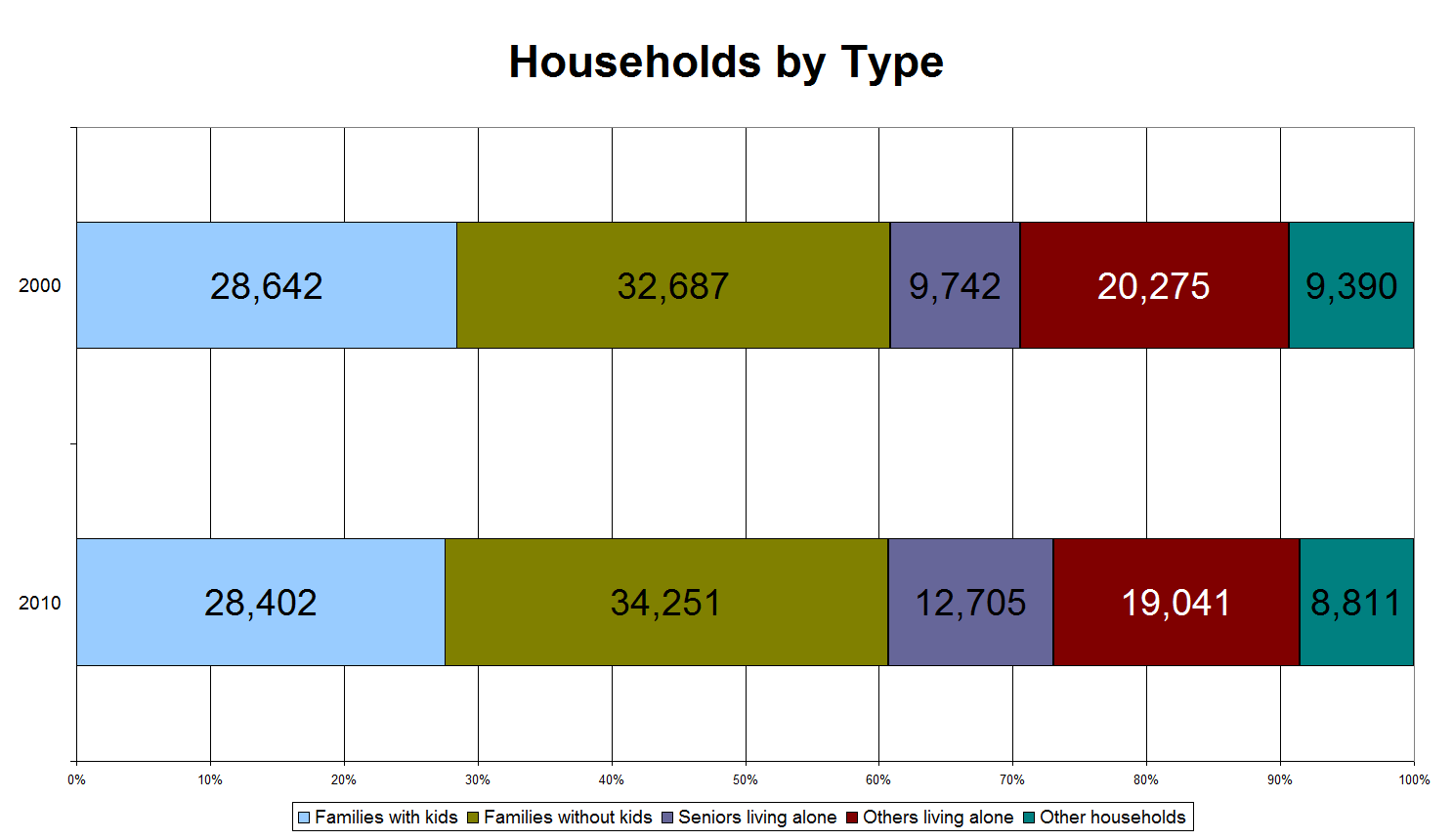Discussions of Marin’s development often lack data but are long on anecdote and impressions, giving misguided assertions about Marin's population or housing undue cachet. But if Marin wants to genuinely plan for the future, it must face the facts of its people and its housing market: there is strong demand for larger apartments in Southern Marin and smaller apartments elsewhere; there are more kids and more people living alone; and that the graying population will need to be able to downsize.
Graying Needs
Between the 2000 and the 2010 Census, Marin’s population grew by about 2 percent and its median age increased three years, from 41.3 years old to 44.5. While the proportion of school-aged children increased by about 1 point, the proportion of middle-aged people plummeted by 10 points; those aged 55 and up increased by a similar amount. So, while we got older, our families grew a bit.
And though our average household got a bit larger, the number of people living alone, especially seniors has already started to increase faster than the population as a whole, while the proportion of families has actually gone down.
The shift is divergent between Southern Marin and the rest of the county. While the median age of Southern Marin has kept pace with the rest of the county, it's been attracting families. The number of people living alone actually declined by 2.5 percent in Southern Marin while it jumped 9.4 percent everywhere else. The population of elementary-aged kids positively boomed, growing an astounding 17.3 percent while the rest of the county’s population shrank by 1.1 percent.
Yet even here, the continued shift to older individuals means its familial boom can’t continue without seniors leaving the region. Southern Marin is where the families are going, it’s true, but it’s aging just as quickly. Unless those seniors start to leave or new family housing is built in Southern Marin, housing costs are going to continue to climb into the stratosphere.
As this shift away from families and towards empty-nesters goes on, people will increasingly use family-sized homes for couples and singles. Already we have 1.17 bedrooms per person compared to 0.95 for the state and 1.15 for the country at large. If we want to keep our homes turning over while keeping our long-term residents in town, we need to allow space for people to downsize into. Senior housing, small single-family homes and the like would allow people to transition without leaving out of the county. Building such homes near transit would give seniors flexibility once it’s no longer feasible to drive, incidentally a goal of AARP.
Squeezing the Market
Rents reflect the shifting demands in Marin's largely stagnant market. The average rent for a three bedroom apartment has skyrocketed in Southern Marin, moving up 28 percent to $3,232 in just a year, from the first quarter of 2011 and now. Studio rents there have stayed fairly steady, increasing only 4 percent in the same time period. In Central Marin, however, studios and two-bedroom apartments have dominated the market's rise, with average rent increasing by 14 percent and 17 percent, respectively.
The housing supply has left behind the studio apartment. Marin has been upsizing, replacing small homes for large ones: the number of no- or one-bedroom homes has dropped 19 percent while larger homes have increased 11.9 percent. It means there will quickly be a shortage of studio and one-bedroom apartments, and there's no relief on its way.
Zoning codes currently in force actually punish developers for building small units. Density limits on a per-unit basis encourage developers to build the largest units that can be rented rather than the most rentable mix of units. Other limits, such as maximum floor area or parking minimums, further strains a developer’s capability to build small. ABAG density guidelines only make the problem worse by politicizing density over height, inspiring impassioned speeches against zoning 31 units per acre.
In Southern Marin, where high rents should bring more development, community backlash against any and all development has had a major chilling effect. Who would buy developable land when they see the nightmare faced by the Blithedale Terrace? Those high rents for three bedroom apartments are the result of a major housing shortage. Shockingly, they’re actually approaching the cost of studio apartments on a square-foot basis, something unheard of except in extremely constrained and warped markets.
Bottom Lines
If Marin wants to continue to be a place for families and its seniors, it must move away from density limits and allow the market to adjust. San Rafael is already doing this with the Downtown Station Area Plan, which maintains height limits but abolishes density limits. Southern Marin could get a boost from the Mill Valley General Plan update if it’s paired with permitting process reform.
Marin can’t be held in stasis; its housing supply is built for an increasingly small demographic – the home-owning family – leaving the childless, seniors, and renting families to compete with extraordinarily high prices. If Marin tries to steer clear of infill development it will only shut out all but the wealthiest of new residents and those lucky enough to get a spot in affordable housing. We’ll be forced to build nonprofit housing, burdening municipal and county budgets with people who need services but whose homes are exempt from property and parcel taxes. Marin is changing, and our governments and residents need to let our housing supply do the same.
